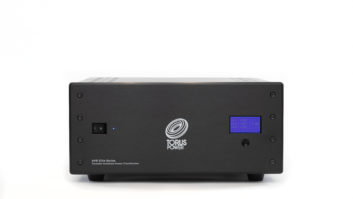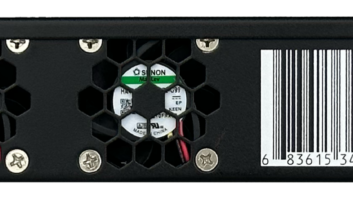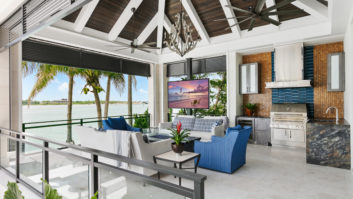Making Power Management a Top Priority for Every System Design

Power management should be a mandatory, no-arguments category for the customintegrated system. So why do integrators encounter resistance from clients when trying to sell power products?
Power management is the foundation of every system. Any integrator with some mileage on him has learned the hard way that without clean, stable power, a system will not perform at its peak. Unprotected or under-protected systems can, and most likely, will lock up, causing service interruptions and even worse, irreparable damage to components.
So with that in mind, it’s important to review not only what power management products are and what they do, but how to factor them into system design, and how to secure client assent to making them part of your projects.
Protection and Performance
As Panamax/Furman’s director of marketing John Benz, explains it, system protection and system performance are the two primary concerns that power management products address.
“Protection should be a top-of-mind concern for any system design,” he asserted. “Installations that have relatively ‘good’ AC power (stable voltage, little risk of lightning, low AC line noise) still require proper protection, line filtering, and isolation from other electronics at the point of use.”

Left: Panamax/Furman’s John Benz said that with high-performance power management components, an A/B demo, or ‘noise sniffer’ demo can be performed at a dealer showroom or at the installation location. Above: Panamax’s M4320-PRO combines the company’s BlueBOLT power and energy management with pro-level linear noise filtration for enhanced AV performance.

Benz further noted that even on a dedicated circuit, there will be a level of noise and volatility on the AC line that needs correction to ensure that the system’s performance, reliability, and longevity will not be compromised from degradation of internal components caused by minor surges and spikes, or the masking effects of AC line noise on highdefinition audio and video content.
Lowell Manufacturing’s director of engineering, Kevin Ditch, says that when protecting a client’s investment in expensive high-end electronics, surge protection is too important to leave out of the project. “We have developed a variety of formats to accommodate every budget,” he said. “Surge suppression can be included in the power strip or panel, so it need not stand out as a separate line item but be considered part of the total power package.”
John Wills, AV manager at Tripp Lite, said that installing an effective power management solution can help ensure a dealer’s ability to meet or exceed customer expectations with a more reliable and warranted solution. “A dealer can eliminate unnecessary truck rolls when they can provide remote access, control, and diagnostics on a customer’s install through the power management,” Wills said.
Why the Resistance?
Power management seems like it should be a mandatory, no-arguments category. So why do integrators encounter resistance from clients when trying to sell power products?
“Without a doubt, it should be a mandatory category, but because it is a category that is not well understood by the client, it is up to us as a vendor and the specialty dealer to educate them on the differences and risks of inferior protection,” stated Rick Komendera, VP of residential sales, for SurgeX.
Komendera clarified that client resistance often is not so much “if” they will include power protection, but more about at what power level. “Most consumers believe that a home improvement warehouse surge strip will provide all the protection they need. It’s certainly easier to sell a $50 power strip, but it’s not profitable for the dealer, nor is it the right solution for someone investing in a system.”
The number-one challenge of selling power management is a lack of education on the part of the integrator and his client, noted Matthew Roher, business development manager for Pliltron Manufacturing’s Torus Power brand. “Power is both ubiquitous and ambiguous; everyone knows what power is, but very few understand it or what’s necessary to properly manage it,” he said.
Unfortunately, Roher added, power products are typically the first line items to be removed when a project is over budget. “The red herring here is that proper power management is one of the highest performance improvements per dollar spent,” he noted.
Murray Williams, Middle Atlantic Products’ product manager for electrical/electronic products, added that because the term “power management” covers such a broad range of services and capabilities, the challenge lies with getting integrators to accept it as integral and necessary to any installed system. In doing so, it is important for integrators to appreciate the many different power-related causes of system disruption, and to understand which power management solutions are appropriate in each case.
“Successful integrators understand that managed power is a foundational element of any installed system and is essential in ensuring system reliability and happy clients,” Williams noted. “Power management systems that facilitate quick installation and setup while requiring low support overhead and also provide proactive problem resolution and notification, are ideal in this respect.”
Explaining the Benefits
According to Benz, most of Panamax/Furman’s dealers specify power management with every installation. After all, the client is paying for the best experience that they can afford, and it is the integrator’s job to provide the right technology to enable that experience and to prove that the power management component is a necessary part of the system and not an overpriced accessory.
“There are several ways to reach this explanation. With high-performance power management components, an A/B demo, or ‘noise sniffer’ demo (available from many power management manufacturers), can be performed at a dealer showroom or at the installation location,” Benz explained.


Left: SurgeX’s Rick Komendera said that when it comes to power, more often than not the client is buying the recommendation of the dealer. Above: Built for the audio and music industry, SurgeX’s XU315-DC is an online backup solution designed to provide “the purest power, without any interruption.”
For smaller systems that do not require more advanced AC filtering, the focus is often on the protection of the investment, which can be challenging to demonstrate. Benz advises dealers to look to the manufacturer for demonstration videos or white papers that elaborate on the differences between an advanced power management component versus a typical surge strip. “More and more, however,” he explained, “we are finding that system installations require technologies such as battery backup, remote power monitoring, or remote reboot, which are more tangible benefits and easier to explain than long-term protection and noise filtering.”
Tripp Lite’s Wills says that his company encourages its dealers to sell service agreements. “Not only does this provide a recurring revenue stream for a dealer, but enhances the value proposition for a customer by providing on-going, reliable, low-cost service,” he said.
As Komendera elaborated, more often than not when it comes to power, the client is buying the recommendation of the dealer. It’s a category that the end user is not typically familiar with, nor do they research it like they would electronics, speakers, etc. So if the dealer recommends power with enough conviction, it is usually easy to close that sale.
“At SurgeX we make sure to give our dealers a broad range of benefits so that they will always have one that will resonate with their clients,” Komendera explained. “[There’s] surge elimination for total system protection, UPS for uninterrupted system enjoyment, and remote management for reduced service calls/system stability.”
Torus Power’s Roher said that his company believes service calls are the No. 1 cause of integrator profit erosion, making the case for remote monitoring. “The brand of the system will always be that of the integrator, not any of the manufacturers used in the system,” he noted. “When a system doesn’t work, for any reason, it always reflects on the integrator.”
When You Don’t Include Power Management
So what are the consequences of failing to include power management into a project? “No one would ever think of building a mansion on loamy soil with no foundation,” Komendera opined. “You’d inevitably lose your asset.”
A similar case could be made for power management. Beyond the obvious catastrophic loss that could accompany a surge, there are other losses that can occur daily. According to Komendera, studies show that more than 80 percent of surges come from within the home. Failing to properly protect a project can cause some major issues for both the dealer and the client, including loss of system life by components continually absorbing smaller “let-through” surges from MOV-based products, loss of client enjoyment by a system that continually suffers from gear lock up and long service calls to get the system back on line, and loss of client resources by not managing stand-by consumption of the system when it’s off line.
Design Considerations
Simply plugging a power management device into the wall does not ensure the system will not function without issue. Proper care needs to be taken to ensure that the system is wired on the same AC phase to help eliminate ground loops. If it’s a larger system with multiple circuits or its own subpanel, working with an electrician to ensure the load for the panel is balanced will also help eliminate issues.
Komendera counsels integrators that once they do get into the rack stage, proper load calculations are vital. “A 15-amp circuit will provide 1,800 watts of power and a 20-amp will provide 2,400 watts. Always leave some headroom on each circuit, not only for future expansion, but to handle peak transient demands that specialty AV gear can require.”
He also advises integrators to make sure all gear is properly protected, from projectors in ceilings, rear subwoofers, and televisions in rooms other than the main viewing areas.

The Torus Power WM 60 BAL AVR is a 60A wall-mount audio video power conditioner, featuring automatic voltage regulation, Ethernet connectivity and RS-232.
Benz concurred, adding that current capacity (15-amp, 20-amp, or VA for battery backup), number of outlets, installation location, and cable management are all top-level considerations. “Most questions we get are based on specifying the right product for a particular system,” he said, noting that such questions typically include “when should one move from a floor strip to a component model? What level of filtration is needed? When do advanced technologies such as balanced power, power factor technology, and voltage regulation need to be considered?”
Very often, the system’s price point and application, or more specifically, the price point and application of the audio equipment in a system, can be used to guide the choice of power management. “For example,” Benz explained, “a modest 5.1 home entertainment system with a flatpanel display, entry-level AVR, set-top box, Bluray player, and game console is probably fine with a standard component-class power management solution from a reputable AV manufacturer, or even an advanced AV floor strip. Move into a dedicated home theater room, with mono block amplifiers and separates–or an audiophile-class two-channel system–now AC line noise, current compression, and voltage stability quickly become the weak links that prevent optimal performance, requiring more advanced power management solutions.”
Finally, a home control and automation system may require additional technologies such as battery backup or remote reboot. Power is the foundation of the system, so these are all critical to the system design. Excluding or even economizing power management is detrimental to both the integrator and the client. Integrators will be strapped with uncompensated service calls and client dissatisfaction, resulting in fewer referrals and diminished profits, while homeowners will have to deal with unstable system performance and repair costs for damaged components.
Lee Distad (www.leedistad.com) is an Edmonton, Alberta-based custom channel business consultant and freelance writer.







